The match that never ended: a 2018 US Open women's final oral history
By Steve Tignor Aug 09, 2019US Open revamps mixed doubles format, adds $1 million prize to incentivize "biggest names in the sport"
By Associated Press Feb 11, 2025US Open adds a 15th day, moves to Sunday start in 2025
By Associated Press Jan 29, 2025Post-2024 US Open WTA storylines: The Age of Aryna; what's next for Swiatek and Gauff?
By Joel Drucker Sep 09, 2024Post-2024 US Open ATP storylines: The race between Alcaraz and Sinner for No. 1 ... and more
By Joel Drucker Sep 09, 2024Jannik Sinner’s US Open title run won’t clear the air around him entirely
By Steve Tignor Sep 09, 2024Taylor Fritz fails in US Open final, but hope springs for American men's tennis
By Peter Bodo Sep 09, 2024Jannik Sinner storms to second major title, defeats Swift, Kelce-backed Taylor Fritz at US Open
By David Kane Sep 08, 2024Jessica Pegula's willingness to take chances paid off at the US Open
By Peter Bodo Sep 08, 2024Aryna Sabalenka won her first US Open by learning from her past heartbreaks in New York
By Steve Tignor Sep 08, 2024The match that never ended: a 2018 US Open women's final oral history
As Serena Williams returns to New York, she’ll look to build on her runner-up finish from last year—and obliterate the memory of how it ended. We look back, through the eyes of five observers, on one of the most controversial matches in tennis history.
Published Aug 09, 2019
Advertising
Serena Williams has never believed in the value of keeping expectations low. But if there was ever a time when she was going to accept something less than her best, it might have been in 2018 and 2019. In 2017, just before turning 36, she gave birth to her first child. Major-winning mothers have been few and far between. And 36-year-old mothers on tour? Serena was entering new territory.
Naturally, she entered it undaunted. After playing just seven matches over the first six months of 2018, she reached the Wimbledon final. Then, after playing three matches over the summer, she reached the US Open final. When 2019 began, Serena seemed ready to take her place on the sport’s mountaintop again.
“I always expect to reach the sky, and anything below it is not good enough for me,” Serena said at the Australian Open. “I just think now that I’m going in the right direction.”
A week later, when Serena beat world No. 1 Simona Halep in the fourth round, she sounded as hungry for success as a tour rookie: “Each day, each match, each tournament I’m learning something,” Williams said. “I think today I’m just learning that I can—I have to fight for titles. I have to fight for matches. Actually, I don’t have any titles yet, but I’m just fighting for matches.

The match that never ended: a 2018 US Open women's final oral history
© 2019 Getty Images
Advertising
Getty Images
At that moment, it would have been hard for Serena, or anyone else, to believe that six months later she would still be without a title in her comeback. Rather than a return to glory, Serena’s 2019 has been a mix of promising performances and unfortunate setbacks, nagging injuries and ill-timed illnesses.
At the Australian Open, she led Karolina Pliskova 5–1 in third set of their quarterfinal before rolling her ankle. At Indian Wells, she beat Victoria Azarenka before retiring with a viral illness in her next match. In Miami and Rome, she withdrew with injuries. At the French Open, she lost to unproven Sofia Kenin.
At Wimbledon, she made it to the final before falling to Halep in just 56 minutes.
“Grueling,” was how Serena described her ups and downs. Was age finally taking its toll? As the US Open approached, Williams tried to find inspiration in her results from 2018.
“I feel like I’ve had some great runs last year, and I’m hoping to still build on that this year,” she said.
Would anyone be surprised if Serena had her final hurrah, after all? It’s hard to imagine her settling for anything less.

The match that never ended: a 2018 US Open women's final oral history
© 2018 Getty Images
Advertising
Getty Images
Which brings us to Serena’s return to Flushing Meadows, in just over two weeks. Last year’s US Open final, which Williams lost to Naomi Osaka, was one of the sport’s all-time anti-classics. By its end, it had devolved into a chaotic contretemps between Serena and chair umpire Carlos Ramos, one that would become a proxy for wider questions about gender and race.
A year later, we look back on that wild, unhappy night through the eyes of a former US Open champion, a journalist, a photographer, a former chair umpire and a tennis-loving author. As you’ll see, Osaka vs. Serena hasn’t faded in people’s memories, and the question of who was at fault, and what it all meant, is still in the eyes of the beholder.
> Lindsay Davenport:1998 US Open champion and Tennis Channel commentator
I was calling the match with Mary [Carillo] that night, and I was looking forward to seeing Serena try to tie the major title record. I’d also been helping out Madison Keys during the tournament, and I’d watched Osaka, who beat Madison in the semifinals, up close.
I remember thinking, ‘Wow, she’s improved so much.’ Over the course of the two weeks in Flushing Meadows, Naomi was so much more disciplined than before; she was setting up for her shots and going for them at the right time. It was obvious she had put in a lot of work.
I said to Madison’s agent, Max [Eisenbud], ‘She’s going to start winning Slams.’ He said, ‘You mean, now?’ I said, ‘I think she’s going to do it.’
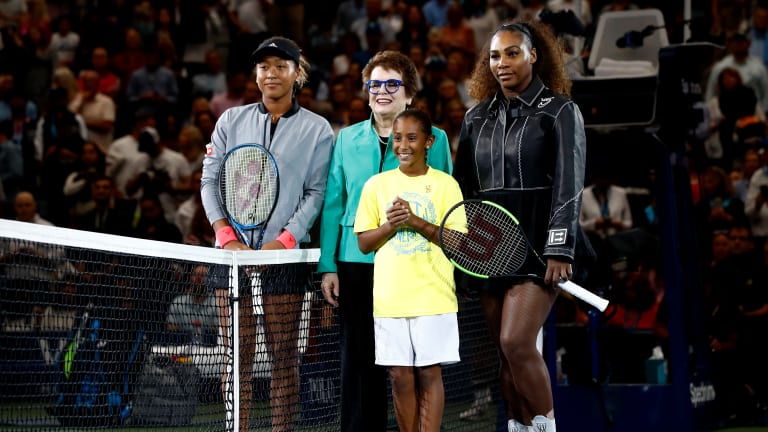
The match that never ended: a 2018 US Open women's final oral history
© 2018 Getty Images
Advertising
Getty Images
> Rowan Ricardo Phillips:Author of The Circuit: A Tennis Odyssey
I was confident in where Serena’s game was, because of how she had handled [Anastasija] Sevastova in the semis. I thought that match was going to be Roberta Vinci all over again. [Vinci upset Williams in the 2015 Open semifinals.] Sevastova has the same slice and finesse. But Serena was in control of the situation. I also thought it would help her to have played Osaka before [Osaka beat Serena in Miami earlier that year, 6–3, 6–2], so she would know what to expect. Naomi’s game would play into Serena’s groove.
> Anita Aguilar:Photographer for TENNIS.com
There was a lot of stress and anticipation among the photographers that day. There’s always stress before a final, because you’ve waited two weeks to capture the tournament-winning moment. But there was even more energy this time, because Serena was in her comeback year, and she could tie the Slam record.
When I got courtside, my attention shifted from Serena to Osaka. Her hair is normally so photogenic; every tennis photographer probably has a portfolio of shots of her hair. But this time she had it tied back—I felt like she meant business. And I had noticed throughout the tournament that she was less expressive than she had been in the past. I wondered how she would handle her first Slam final, but it was really striking how composed she was. I was impressed that she could be so calm in between points and so aggressive during them.
> Lindsay Gibbs:Sports reporter for Think Progress
I was incredibly excited for the match, because either outcome was going to be a great moment for tennis. Either Serena was going to complete her miraculous comeback, or Naomi was going to win her first major at 20. This felt like a special night, and there aren’t many bigger stages in women’s sports than the US Open final, on Saturday night, in Arthur Ashe Stadium.
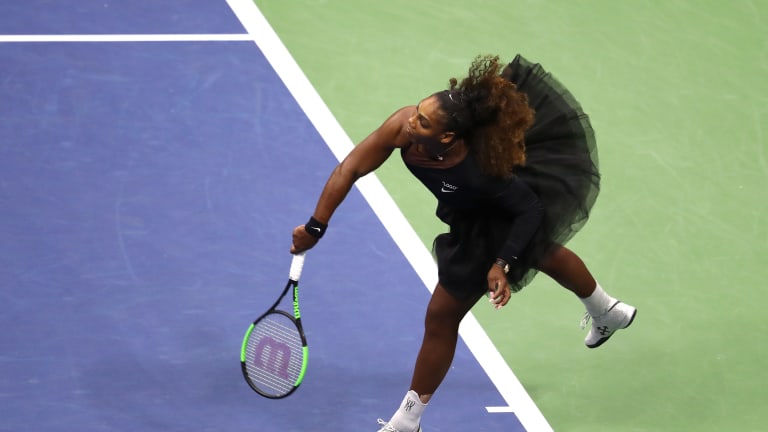
The match that never ended: a 2018 US Open women's final oral history
© 2018 Getty Images
Advertising
Getty Images
> Miguel Seabra:Former chair umpire and Portugal-based commentator for Eurosport
I’d been paying attention to Osaka ever since she’d been coached by my countryman and friend Antonio Van Grichen. I was aware of her potential. I had also known Carlos Ramos—another countryman—quite well since the late 1980s. We worked together on a daily basis for a few years, when I was a professional umpire. We were officiating four matches a day on Satellite circuits with no linesmen, so I knew he had the right mindset to be an elite umpire. He had a fair thought process and good vision, and he was discreet. He’s still one of the best people I know.
Then came his “coaching” warning. [In the second game of the second set, Ramos spotted Williams’ coach, Patrick Mouratoglou, making a signal to her, telling her to move up in the court. Ramos issued Williams a warning for coaching.] I remember putting my hands on my head and saying, “No, no, no!” I sensed big trouble was coming.
> Rowan Ricardo Phillips: The match was weird. Serena had been so good in the semis, but now she was really uncomfortable. It was Naomi who was showing a champion’s mentality; she was throwing Serena’s serve right back at her. Serena is usually so good at changing the pressure on the other side of the net, but Naomi was so unflappable that she was giving Serena nothing to work with.
I was on the edge of my seat; Serena’s frustration was almost too much to watch. But I also thought this was a match tennis fans had been thirsty for. It had been a long time since we’d seen a changing of the guard, and it was playing out that way.
And then Ramos called Serena for coaching. I said, “WHAT? I’ve never seen Serena take a coaching timeout.” Then when I saw the replay, it was like, “Oh, yeah, that’s coaching.” I remember thinking, “What is Patrick doing?”
> Lindsay Davenport: When we heard the coaching call, Mary and I turned and looked at each other; we were stunned. Serena doesn’t get coached, and she isn’t even someone who usually listens to what her box is saying. But it was her reaction that was more surprising. She took it personally. She’s been in this situation so many times, I thought she would have shrugged it off.
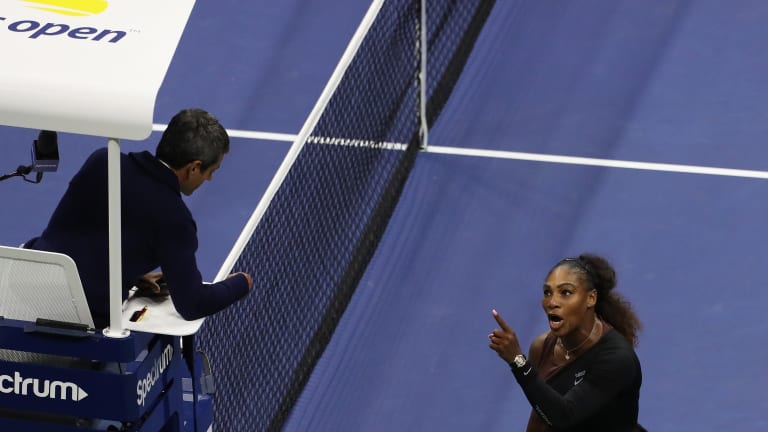
The match that never ended: a 2018 US Open women's final oral history
© 2018 Getty Images
Advertising
Getty Images
> Lindsay Gibbs: It was clear Patrick was coaching, but I didn’t think it was a call that had to be made; Serena was angry and confused, because it wasn’t as if she had asked to be coached. It was such a small gesture [from Mouratoglou], you wonder if she even saw it.
[Later in the second set, Williams slammed her racquet to the court; having already given her a warning for coaching, Ramos now issued her a point penalty.]
I had this sinking feeling when Serena and Ramos started arguing about the point penalty. For her, it was the ultimate frustration, because he had started it by accusing her of doing something she would never do, and now he was punishing her again.
> Anita Aguilar: When I saw that Osaka was close to winning, I went to the photographer’s dugout at one end of the court. There was no play happening, but there was a buzz in the stands. I was on the opposite side of the court from Serena, and I could see her gesticulating toward Carlos. None of us could hear anything, but word got around that she had lost a point.
[When Williams continued to argue with Ramos, he issued a third violation, this one a game penalty that put Osaka up 5–3 in the second set, four points from the title.]
Then we could hear jeering, and things became a blur. I had a good view of Osaka, who was turned away from the net, making eye contact with her player box. She exhaled a few times, and she put two fingers on her neck to check her pulse. It seemed like the more chaotic the match was, the calmer she became.
Then the players switched sides, and Serena walked toward us. She was the complete opposite of Osaka: distressed, on the verge of tears. She was wearing that wonderful tutu skirt, and she kept smoothing it out, which seemed to be her way of trying to calm herself down.
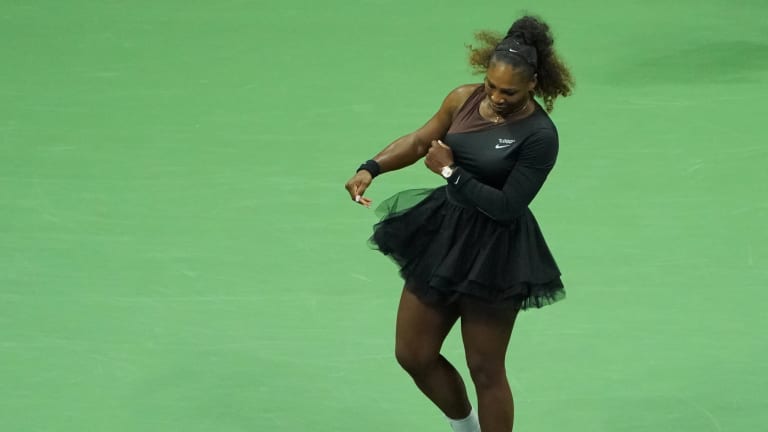
The match that never ended: a 2018 US Open women's final oral history
© AFP/Getty Images
Advertising
Getty Images
> Miguel Seabra: People keep saying Carlos is a stickler, using that expression in a negative way. Knowing him personally, I have confidence in his fairness and understanding of any situation. We also shouldn’t forget that he must have umpired Serena countless times since 1999 without any issues.
My main question was the coaching violation. I thought: Is it necessary? Because Serena gave him no other chance on the point penalty and the game penalty. He had to issue those. If he didn’t, players would never respect him, and he would have been publicly roasted. As it was, Carlos behaved like an umpire should, and acted consistently with his way of umpiring. And he was crucified for it.
Seeing the situation exploding on court and on social media, I tweeted my opinion on the subject and on Carlos. I wrote that Serena had brought things that were uncalled for, and that Carlos was one of the best people I know. I got a lot of abuse for those tweets, and even got a few messages from Patrick Mouratoglou. But things would get worse later.
> Lindsay Davenport: l was probably umpired by Ramos at some point during my career, but I can’t remember it, so there must not have been a problem. I was completely down the middle about what happened between Serena and Ramos—I thought she could have done less, and he could have done more. He owed it to her to let her know what was going to happen if she kept arguing; if he had said, ‘Serena, one more word and you’re going to get a game penalty, period,’ then it would have been OK. Is that in the rule book? No. Does it happen during matches? Yes.
[Osaka held serve to clinch a 6–2, 6–4 victory, but the trophy ceremony was marred by a torrent of boos from an audience that felt Williams had been robbed of a chance to stage a comeback.]
> Ricardo Rowan Phillips: The boos were the sound of a crowd that’s just been jilted out of an emotional and financial investment. I felt like we had something taken from us that night—a great match, a potential comeback, an introduction to a new star in Osaka like we’ve never seen before. Ramos had numerous opportunities to exercise a more humane judgment. You go back to the clips of what [Roger] Federer said in the 2009 US Open final; that was an amazing reproach of a chair umpire. He wasn’t penalized the way Serena was.
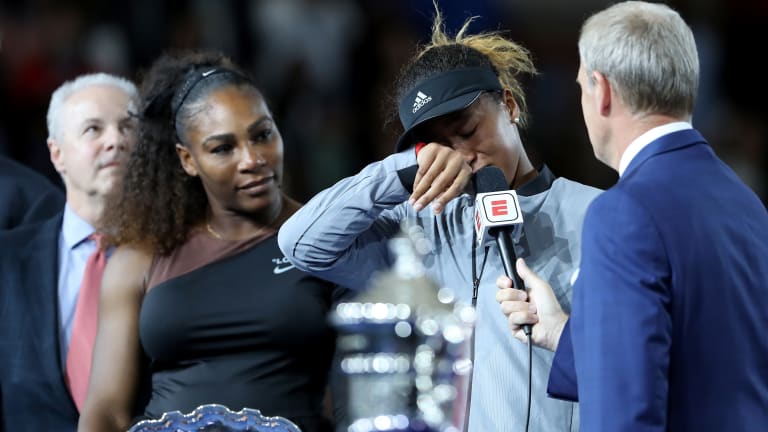
The match that never ended: a 2018 US Open women's final oral history
© 2018 Getty Images
Advertising
Getty Images
> Anita Aguilar: The trophy ceremony was difficult to photograph. I felt sad that Naomi’s moment of elation was taken away. You could see how complicated it was for her. She was playing her idol; her coach [Sascha Bajin] was Serena’s longtime hitting partner; and then there was the way it ended, and the crowd reaction.
Another photographer ran up to me and said, “That was the most exciting match I’ve seen in years!” These are the moments photographers live for. The Serena-Ramos exchange was history; you saw those photos everywhere for weeks. I could understand that, but to me the images of Naomi—of her checking her pulse, and looking like she didn’t know how to react during the trophy ceremony—were the most interesting about the night.
> Miguel Seabra: After the tournament, I spent 30 minutes on the phone with Carlos, and we talked about a lot of things regarding the incident. I was aware he couldn’t talk to media without permission, so I didn’t tell anyone.
The next day, I was invited by a Portuguese newspaper to write a personal column on the subject, and I wrote a long article where I quoted a sentence of Carlos’ from our conversation—‘There’s no such thing as umpiring a la carte,’ he said. ‘I’m doing quite OK, don’t worry about me’—just to show I was actually more worried than him.
The article went viral, and that quote was shown everywhere, especially in the United States. I started getting calls all day and night. I got interview requests from Good Morning America, and everyone wanted Carlos’ contact information. Reporters from NBC and the New York Times came to Lisbon to interview me, and they even went to Cacém, the suburb where Carlos grew up. A British tabloid went through my Facebook profile and created a big article, distorting a lot and creating controversy where there wasn’t any. It was so intense that I had to disconnect my phone. After a week, I was emotionally spent.
But my view on the match never changed. Many used the incident opportunistically to serve their own political and social agendas. Many accusations made about Carlos were obnoxious. It wasn’t about racism, sexism or misogyny; it was about rules.

The match that never ended: a 2018 US Open women's final oral history
© 2018 Getty Images
Advertising
Getty Images
> Lindsay Gibbs: I knew the match would make some people angry. Everything with Serena is bigger than tennis, and she took it there when she talked about herself as a woman and a mother during her argument. It’s possible to see this as just a tennis story, but I don’t think you can ignore the fact that as a black woman in a mostly white sport, Serena’s emotions are scrutinized differently, and that she feels a different kind of pressure.
But I don’t think I realized how much of a touchstone it would become, and how much Serena’s experience resonated with female athletes. I was interviewing [Notre Dame women’s basketball coach] Muffet McGraw, and she talked about how women aren’t allowed to be angry or aggressive, and aren’t allowed to argue with referees, and she used Serena as her example. It made me realize that these women feel like they’re being policed differently than men.
I’m still devastated by what happened, but the match did become an entry point to talk about a double standard. And I was also happy to see that Osaka continued to be great, and that she got her own moment when she won the Australian Open a few months later.
> Lindsay Davenport: We sat in the booth for half an hour afterward, in shock. So many things were happening at once. We saw Serena’s agent, Jill Smoller, walk around the stadium to say something to the US Open staff. Then Patrick was doing an interview on ESPN about the coaching call. It felt like we were in a sinking ship, and no one was coming to the rescue.
I ended up feeling sad for Osaka and Serena. We expected something amazing that day, and no one really went away happy.
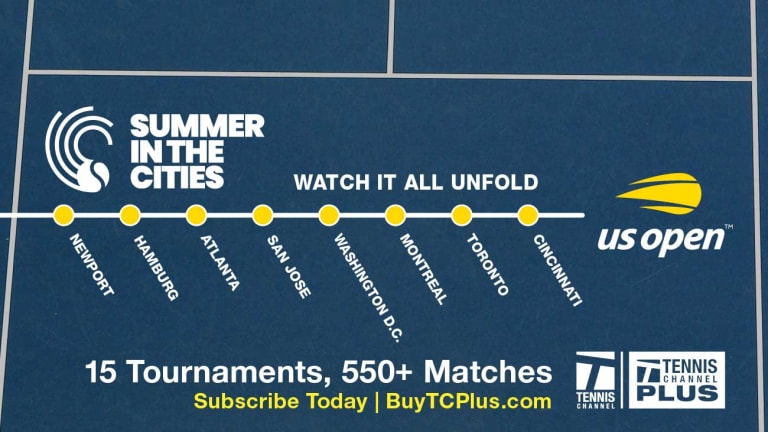
The match that never ended: a 2018 US Open women's final oral history